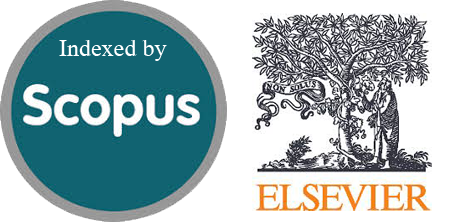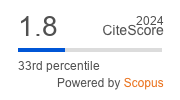Comparison of Mycobacterium Tuberculosis Image Detection Accuracy Using CNN and Combination CNN-KNN
Abstract
Mycobacterium tuberculosis is a pathogenic bacterium that causes respiratory tract disease in the lungs, namely tuberculosis (TB). The problem is to find out the bacterial colonies when the observation is still done manually using a microscope with a magnification of 1000 times. It took a long time and was tiring for the observer's eye. Based on this background, an automatic detection system for Mycobacterium tuberculosis was designed. Mycobacterium tuberculosis image data were obtained from the Semarang City Health Center. The dataset used is 220 sputum images, which are divided into 180 training data and 40 testing data. The method used in this research is a combination of Convolutional Neural Network (CNN) and K-Nearest Neighbor (KNN). CNN is used for image feature extraction. Furthermore, the results of the CNN feature extraction are classified using the KNN. The results of the accuracy of the combination of CNN-KNN and CNN were also compared. The stages of the process are color transformation, feature extraction, and data training with CNN, then classification with KNN. The results of the classification test between CNN and the CNN-KNN combination show that the CNN-KNN combination is better. The result of CNN-KNN accuracy is 92.5%, while CNN's accuracy is 90%.
Downloads
References
N. G. Schwartz et al., “Nationwide tuberculosis outbreak in the USA linked to a bone graft product: an outbreak report,” Lancet Infect. Dis., vol. 22, no. 11, pp. 1617–1625, 2022, doi: 10.1016/s1473-3099(22)00425-x.
K. N. Meiah Ngafidin, S. Suryono, and R. R. Isnanto, “Diagnosis of Tuberculosis by Using a Fuzzy Logic Expert System,” Proc. 2019 4th Int. Conf. Informatics Comput. ICIC 2019, 2019, doi: 10.1109/ICIC47613.2019.8985788.
M. M. Ibrahim et al., “Trends in the incidence of Rifampicin resistant Mycobacterium tuberculosis infection in northeastern Nigeria,” Sci. African, vol. 17, p. e01341, 2022, doi: 10.1016/j.sciaf.2022.e01341.
J. L. Díaz-Huerta, A. del Carmen Téllez-Anguiano, M. Fraga-Aguilar, J. A. Gutiérrez-Gnecchi, and S. Arellano-Calderón, “Image processing for AFB segmentation in bacilloscopies of pulmonary tuberculosis diagnosis,” PLoS One, vol. 14, no. 7, pp. 1–14, 2019, doi: 10.1371/journal.pone.0218861.
J. Chakaya et al., “Global Tuberculosis Report 2020 – Reflections on the Global TB burden, treatment and prevention efforts,” Int. J. Infect. Dis., vol. 113, pp. S7–S12, 2021, doi: 10.1016/j.ijid.2021.02.107.
M. Tuberculosis and M. Tuberculosis, “Positive Profile of Acid-fast bacilli in Patients with Clinical Diagnosis of Pulmonary Tuberculosis at the Semarang Public Health Center,” J. Lab. Medis, vol. 04, no. 02, pp. 95–100, 2022, doi: https://doi.org/10.31983/jlm.v4i2.8552.
C. Vilchèze and L. Kremer, “ Acid-Fast Positive and Acid-Fast Negative Mycobacterium tuberculosis : The Koch Paradox ,” Microbiol. Spectr., vol. 5, no. 2, pp. 1–14, 2017, doi: 10.1128/microbiolspec.tbtb2-0003-2015.
M. I. Shah et al., “Ziehl–Neelsen sputum smear microscopy image database: a resource to facilitate automated bacilli detection for tuberculosis diagnosis,” J. Med. Imaging, vol. 4, no. 2, p. 027503, 2017, doi: 10.1117/1.jmi.4.2.027503.
K. S. Mithra and W. R. Sam Emmanuel, “GFNN: Gaussian-Fuzzy-Neural network for diagnosis of tuberculosis using sputum smear microscopic images,” J. King Saud Univ. - Comput. Inf. Sci., vol. 33, no. 9, pp. 1084–1095, 2021, doi: 10.1016/j.jksuci.2018.08.004.
S. R. Reshma and T. Rehannara Beegum, “Microscope image processing for TB diagnosis using shape features and ellipse fitting,” 2017 IEEE Int. Conf. Signal Process. Informatics, Commun. Energy Syst. SPICES 2017, pp. 1–7, 2017, doi: 10.1109/SPICES.2017.8091342.
E. Kotei and R. Thirunavukarasu, “Computational techniques for the automated detection of mycobacterium tuberculosis from digitized sputum smear microscopic images: A systematic review,” Prog. Biophys. Mol. Biol., vol. 171, pp. 4–16, 2022, doi: 10.1016/j.pbiomolbio.2022.03.004.
R. A. Rizal, N. O. Purba, L. A. Siregar, K. Sinaga, and N. Azizah, “Analysis of Tuberculosis (TB) on X-ray Image Using SURF Feature Extraction and the K-Nearest Neighbor (KNN) Classification Method,” Jaict, vol. 5, no. 2, pp. 9–12, 2020, doi: http://dx.doi.org/10.32497/jaict.v5i2.1979.
M. K. Puttagunta and S. Ravi, “Detection of Tuberculosis based on Deep Learning based methods,” J. Phys. Conf. Ser., vol. 1767, no. 1, 2021, doi: 10.1088/1742-6596/1767/1/012004.
R. O. Panicker, K. S. Kalmady, J. Rajan, and M. K. Sabu, “Automatic detection of tuberculosis bacilli from microscopic sputum smear images using deep learning methods,” Biocybern. Biomed. Eng., vol. 38, no. 3, pp. 691–699, 2018, doi: 10.1016/j.bbe.2018.05.007.
F. Sharifonnasabi et al., “Hybrid HCNN-KNN Model Enhances Age Estimation Accuracy in Orthopantomography,” Front. Public Heal., vol. 10, no. May, pp. 1–14, 2022, doi: 10.3389/fpubh.2022.879418.
S. Shanjida, M. S. Islam, and M. Mohiuddin, “MRI-Image based Brain Tumor Detection and Classification using CNN-KNN,” 2022 IEEE IAS Glob. Conf. Emerg. Technol. GlobConET 2022, no. May, pp. 900–905, 2022, doi: 10.1109/GlobConET53749.2022.9872168.
R. Dinesh Jackson Samuel and B. Rajesh Kanna, “Tuberculosis (TB) detection system using deep neural networks,” Neural Comput. Appl., vol. 31, no. 5, pp. 1533–1545, 2019, doi: 10.1007/s00521-018-3564-4.
K. Swetha, B. Sankaragomathi, and J. B. Thangamalar, “Convolutional Neural Network based Automated Detection of Mycobacterium Bacillus from Sputum Images,” Proc. 5th Int. Conf. Inven. Comput. Technol. ICICT 2020, pp. 293–300, 2020, doi: 10.1109/ICICT48043.2020.9112501.
A. E. B. Alawi, A. Al-Basser, A. Sallam, A. Al-Sabaeei, and H. Al-Khateeb, “Convolutional Neural Networks Model for Screening Tuberculosis Disease,” 2021 Int. Conf. Technol. Sci. Adm. ICTSA 2021, pp. 0–4, 2021, doi: 10.1109/ICTSA52017.2021.9406520.
M. F. Wahid, M. J. Hasan, M. S. Alom, and S. Mahbub, “Performance Analysis of Machine Learning Techniques for Microscopic Bacteria Image Classification,” 2019 10th Int. Conf. Comput. Commun. Netw. Technol. ICCCNT 2019, pp. 1–4, 2019, doi: 10.1109/ICCCNT45670.2019.8944597.
S. Y. Sourab and M. A. Kabir, “A comparison of hybrid deep learning models for pneumonia diagnosis from chest radiograms,” Sensors Int., vol. 3, no. February, p. 100167, 2022, doi: 10.1016/j.sintl.2022.100167.
C. Shorten and T. M. Khoshgoftaar, “A survey on Image Data Augmentation for Deep Learning,” J. Big Data, vol. 6, no. 1, 2019, doi: 10.1186/s40537-019-0197-0.
L. I. U. Wei, C. H. E. N. Jinming, L. I. U. Bo, H. U. Wei, W. U. Xingjin, and Z. H. O. U. Hui, “Tongue image segmentation and tongue color classification based on deep learning,” Digit. Chinese Med., vol. 5, no. 3, pp. 253–263, 2022, doi: 10.1016/j.dcmed.2022.10.002.
S. Kant, “Towards Automated Tuberculosis detection using Deep Learning,” 2018 IEEE Symp. Ser. Comput. Intell., pp. 1250–1253, 2018, doi: 10.1109/SSCI.2018.8628800.
B. Hemalatha, B. Karthik, C. V. Krishna Reddy, and A. Latha, “Deep learning approach for segmentation and classification of blood cells using enhanced CNN,” Meas. Sensors, vol. 24, no. September, p. 100582, 2022, doi: 10.1016/j.measen.2022.100582.
N. Zamri et al., “River quality classification using different distances in k-nearest neighbors algorithm,” Procedia Comput. Sci., vol. 204, no. 2021, pp. 180–186, 2022, doi: 10.1016/j.procs.2022.08.022.
S. Majumdar, P. Pramanik, and R. Sarkar, “Gamma function based ensemble of CNN models for breast cancer detection in histopathology images,” Expert Syst. Appl., vol. 213, no. PB, p. 119022, 2023, doi: 10.1016/j.eswa.2022.119022.
S. Coulibaly, B. Kamsu-foguem, D. Kamissoko, and D. Traore, “Deep Convolution Neural Network sharing for the multi-label images classification,” Mach. Learn. with Appl., vol. 10, no. September, p. 100422, 2022, doi: 10.1016/j.mlwa.2022.100422.
M. Suvarna and N. Venkategowda, “Performance Measure and Efficiency of Chemical Skin Burn Classification Using KNN Method,” Procedia Comput. Sci., vol. 70, pp. 48–54, 2015, doi: 10.1016/j.procs.2015.10.028.
P. Ghose, M. A. Uddin, U. K. Acharjee, and S. Sharmin, “Deep viewing for the identification of Covid-19 infection status from chest X-Ray image using CNN based architecture,” Intell. Syst. with Appl., vol. 16, no. May, p. 200130, 2022, doi: 10.1016/j.iswa.2022.200130.
Copyright (c) 2023 Jurnal RESTI (Rekayasa Sistem dan Teknologi Informasi)

This work is licensed under a Creative Commons Attribution 4.0 International License.
Copyright in each article belongs to the author
- The author acknowledges that the RESTI Journal (System Engineering and Information Technology) is the first publisher to publish with a license Creative Commons Attribution 4.0 International License.
- Authors can enter writing separately, arrange the non-exclusive distribution of manuscripts that have been published in this journal into other versions (eg sent to the author's institutional repository, publication in a book, etc.), by acknowledging that the manuscript has been published for the first time in the RESTI (Rekayasa Sistem dan Teknologi Informasi) journal ;








